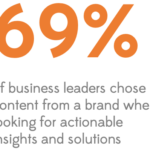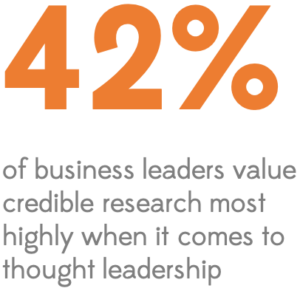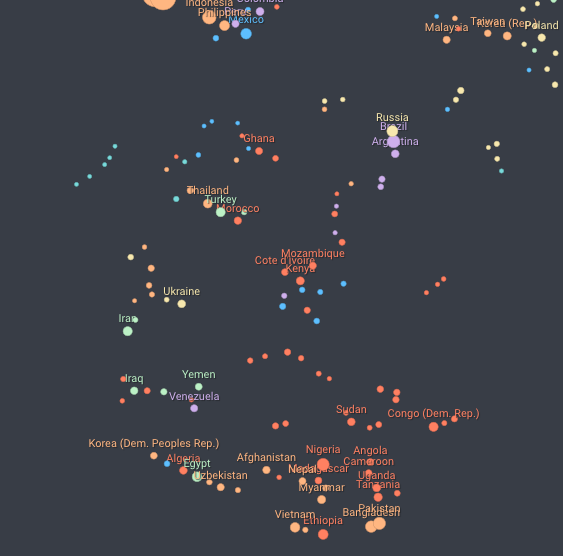Data + Story + Design
Gareth Lofthouse
Rewrite the recipe for audience engagement
Time-poor, super discerning, and inundated with competing claims on their attention.
As B2B marketers, this is how we often picture our business audience. The task of trying to engage such an impossibly demanding group of people is enough to make all but the toughest professionals quail.
 There’s some truth in this – but it’s only half the picture. Business leaders also have characteristics that, we, as communicators, can work with. For example, they are uncommonly curious. They are constantly on the hunt for new data-driven opportunities. Above all, they are hungry for the knowledge and insights that can give them an edge in a fast-changing market.
There’s some truth in this – but it’s only half the picture. Business leaders also have characteristics that, we, as communicators, can work with. For example, they are uncommonly curious. They are constantly on the hunt for new data-driven opportunities. Above all, they are hungry for the knowledge and insights that can give them an edge in a fast-changing market.
Together, these traits make them avid consumers of high-quality content. According to our latest research, Learning from Leaders, in their search for insight, senior executives spend on average four hours reading thought leadership content every week – and that rises to over five hours for CEOs.
Find a way to satisfy this appetite, and you stand a very good chance of getting your content read and your message through. But of course, to do this successfully, you need the right recipe.
How to engage, inform and influence business leaders
Fortunately, when it comes to consuming content, business leaders have told us what they want: the ingredients that make them stop for a moment and pay attention.
The answer is both familiar and novel.
Familiar, because the ingredients required to reach this audience are already being used by marketers as part of their campaigns – albeit with wildly varying degrees of effectiveness.
Novel, because hardly anyone is serving the ingredients up in a recipe that real businesspeople – rather than the corporate stereotype – find very palatable. There is a need for a much more imaginative approach. But if you can get it right, your audience will reward you with their time and attention.
Right ingredients, wrong preparation
Our research, as well as our practical experience of working with over 60 global brands, tells us three things really matter if you’re trying to engage an executive audience: interesting data, great storytelling, and design that brings your ideas to life.
These ingredients are well-known, of course, but the campaign-by-numbers approach adopted by a lot of brands doesn’t fire up an audience. So, here, we present a meal in three courses for a more appetising thought leadership campaign – and offer suggestions on how to spice the recipe up.
1. The Data
 Data provides the filling in your thought leadership sandwich. Business audiences are looking for the data point that gives them a new perspective on their business and the world it operates in. In our recent research report we found that, when business executives search for interesting content, they’re primarily looking for unique insights backed by credible research: that nugget of information that provides the actionable insight and the news value. This is also the component that helps your work pass the credibility test with executives. In other words, you have the evidence to back up what you’re trying to say.
Data provides the filling in your thought leadership sandwich. Business audiences are looking for the data point that gives them a new perspective on their business and the world it operates in. In our recent research report we found that, when business executives search for interesting content, they’re primarily looking for unique insights backed by credible research: that nugget of information that provides the actionable insight and the news value. This is also the component that helps your work pass the credibility test with executives. In other words, you have the evidence to back up what you’re trying to say.
Build better data:
• Identify a knowledge gap. Which areas of knowledge are particularly appetising to your audience? Stop guessing and use the various tools available to understand their needs and interests.
• Spearfish for the specific data point. In research, precision is paramount: surveys that attempt to “boil the ocean” rarely deliver the killer insight. Research projects are nearly always better if you’re clear on what you’re looking for before you start.
• Apply social listening to a business audience. Social listening and sentiment analysis tools have become popular in B2C storytelling, but, increasingly, we are seeing ways to apply them to B2B campaigns, too.
• Embrace data journalism. Innovative data-analysis tools and techniques are enabling a new cadre of data-savvy journalists to uncover more interesting stories. Harness that skill in your thought leadership campaigns.
2. The Story
Skillful storytelling makes sense of the data and answers the “so what?” in your thought leadership. A logical and compelling structure helps transform abstract concepts into something that resonates with your audience. A good story will also take your audience on a journey, bringing coherence to even the most complex topics and turning ideas and insights into something they can absorb and act on. Data on its own is just noise without narrative – and weak storytelling is why many thought leadership projects fail.
Shake up your storytelling:
• Write the film poster for your campaign. Hollywood excels at the high concept – the ability to pitch a story in a single line. It’s a technique that can help you chose the strongest PR angle for your marketing project.
• Pay for ideas, not word count. Why do we pay more for longer, when what audiences want is shorter but better and more interesting? Invest in the creative process, not the word count.
• Go for non-linear storytelling. Make your content rich and browsable. Business audiences want depth – but delivered in bite-size chunks. Use different stories, content assets, and angles to catch your audience’s interest, and let them explore according to their own interests and preferred format.
3. The Design
Great information design is sorely lacking in a lot of B2B content. The vast majority of branded corporate content looks dull and unimaginative. This is not just an issue of aesthetics, although, of course, it’s important to make your work visually appealing. Ultimately, it’s about visual storytelling: finding the most impactful and efficient way to communicate your message, rather than simply distracting the audience with flashy imagery. The best campaigns we see apply design thinking to the whole audience experience – enticing the reader and making it easier for them to understand and absorb your ideas. Great design is what brings your data and stories to life in a way that’s provocative, impactful and easy for your audience to engage with.
Design that makes an impression:
• Find the beauty in your data. Information is beautiful – as David McCandless demonstrated in his seminal book on information design. But, sadly, that’s not the experience you get with most corporate campaigns: think boring bar charts and, if you’re lucky, a few funky but not very meaningful icons. Be more ambitious and find designers who love data and know how to bring a complex story to life.
• Go for elegant and simple. As so often in life, less is more. More space for your ideas to breathe, less frills and more meaning. As our information design guru Emma Hicks puts it: “If your audience is using precious cognitive power to try and decipher your visuals, they are less likely to engage with the message.”
• Make it shareable. Simple, powerful ideas are easy to grasp and cool to share. Every campaign plan should have a strong focus on producing shareable assets and memes.
• Serve the right course for your horse. What format do executives prefer? Well, they’re a homogeneous bunch. Our research shows that some execs really prize practical case studies and short, data-led articles. Others love podcasts and videos. And yes, there’s still demand in the C-suite for the in-depth thought leadership report. So, you need to give them a menu of options. Courses for horses, so to speak…
All in all, it’s a simple enough recipe. Unfortunately, it’s not one that many marketers are currently whipping up.
In fact, the vast majority of business content that FT Longitude reviews as part of our audit work fail to deliver on at least two out of the three ingredients in this recipe. We’ve covered elsewhere some of the classic pitfalls that cause content to be discounted by executives, but suffice to say that it takes skill and experience to combine them in a way that will make executive mouths water.
It’s even rarer to see the data, the story, and the design coming together in a tasty and surprising dish. Usually, you find some interesting data gets lost because of poor storytelling. Or perhaps a nicely designed and branded campaign turns out to be only skin-deep.
To go from good to great, you need to do something special. Impressing business audiences today is all about how you blend the three ingredients to deliver a compelling experience that makes a lasting impression.
No one has perfected the recipe. Delivering excellence across all the three areas we’ve outlined in this piece is difficult to pull off at the best of times. Throw in some of the obstacles that large organisations have to navigate to get stakeholder buy-in and it begins to look daunting. But hold on to these three ingredients – invest in doing them well individually and in combination – and you can be sure that your thought leadership will serve up a treat for insight-hungry executives.
———————————-
Want to hear more about thought leadership strategy? Read our thought leadership best practice guide to find out more
Speak to the team
We’ll help you to navigate and overcome any challenges you currently face and learn how to get more out of your content.
Book a meeting
About the author: Gareth Lofthouse
Gareth is our chief revenue officer and manages our growing commercial team as we continue to advise some of the biggest B2B companies in the world on their thought leadership strategy. He works with clients to design thought leadership that delivers maximum commercial impact, both in terms of building client relationships and improving brand visibility.
Before joining FT Longitude, he spent nine years as editorial director for EMEA at the Economist Intelligence Unit (EIU). Gareth was instrumental in building the EIU’s thought leadership and survey business, and he has overseen hundreds of custom projects for the Economist’s clients across a range of industries and subject areas. Before that, Gareth led an editorial and creative team for a PR and marketing agency. He has also held several senior editorial positions in business and technology publishing.
 |
Tel:
+44 (0)20 7873 4770
|
Tel:
+44 (0)20 7873 4770



